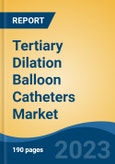Speak directly to the analyst to clarify any post sales queries you may have.
10% Free customizationThis report comes with 10% free customization, enabling you to add data that meets your specific business needs.
Key Market Drivers
Increasing Prevalence of Cardiovascular Diseases
The rising global incidence of cardiovascular diseases is a primary factor contributing to the growth of the Tertiary Dilation Balloon Catheters market. Conditions such as coronary artery disease, driven by factors like sedentary lifestyles, aging populations, and unhealthy diets, are becoming increasingly common. According to the NIH 2025 report, cardiovascular-related deaths are projected to climb from 20.5 million in 2025 to 35.6 million in 2050. As more patients are diagnosed with cardiovascular disorders, the demand for advanced therapeutic interventions rises accordingly. Tertiary dilation balloon catheters are instrumental in procedures like balloon angioplasty, where they help restore blood flow by dilating narrowed or blocked vessels. Their ability to offer precise, minimally invasive treatment options aligns with current clinical needs and enhances outcomes in interventional cardiology.Key Market Challenges
Stringent Regulatory Approval Process
The market faces considerable challenges due to the complex and time-intensive regulatory approval process required for medical devices. Regulatory bodies demand extensive clinical validation, safety testing, and compliance documentation, which can delay time-to-market for new products. These requirements necessitate significant resource investment - posing difficulties especially for small and medium-sized manufacturers. Furthermore, shifting regulatory standards add another layer of complexity, requiring continuous adaptation to evolving compliance frameworks. This dynamic environment not only prolongs development cycles but also raises operational costs, impeding rapid innovation and slowing down the market’s growth momentum.Key Market Trends
Shift Towards Minimally Invasive Procedures
The growing preference for minimally invasive procedures is reshaping the Tertiary Dilation Balloon Catheters market. These interventions offer several benefits over traditional surgeries, including smaller incisions, reduced recovery times, less postoperative pain, and lower risk of infection. Tertiary dilation balloon catheters are integral to such procedures, allowing accurate dilation with minimal trauma to surrounding tissues. Their precision contributes to safer cardiovascular and gastrointestinal interventions, aligning with both clinical goals and patient expectations. Additionally, reduced hospitalization and faster recovery lower healthcare costs, further encouraging the adoption of minimally invasive solutions. This trend is expected to drive sustained demand for these catheters as healthcare providers increasingly prioritize efficiency, patient comfort, and cost-effectiveness.Key Players Profiled in this Tertiary Dilation Balloon Catheters Market Report
- Boston Scientific Corp
- Cook Medical Inc
- Terumo Corporation
- CR Bard Inc
- Braun Melsungen AG
- Abbott Laboratories Inc
- Medtronic Plc
Report Scope:
In this report, the Global Tertiary Dilation Balloon Catheters Market has been segmented into the following categories, in addition to the industry trends which have also been detailed below:Tertiary Dilation Balloon Catheters Market, by Type:
- Silicone Balloon Catheters
- Polyethylene Balloon Catheters
Tertiary Dilation Balloon Catheters Market, by Application:
- Heart Disease
- Vascular Disease
- Digestive Tract Disease
- Urinary System Disease
- Gynaecological Disease
Tertiary Dilation Balloon Catheters Market, by End User:
- Hospitals
- Ambulatory Surgery Centers
- Other End Users
Tertiary Dilation Balloon Catheters Market, by Region:
- North America
- United States
- Canada
- Mexico
- Asia-Pacific
- China
- India
- South Korea
- Australia
- Japan
- Europe
- Germany
- France
- United Kingdom
- Spain
- Italy
- South America
- Brazil
- Argentina
- Colombia
- Middle East & Africa
- South Africa
- Saudi Arabia
- UAE
Competitive Landscape
Company Profiles: Detailed analysis of the major companies present in the Global Tertiary Dilation Balloon Catheters Market.Available Customizations:
With the given market data, the publisher offers customizations according to a company's specific needs. The following customization options are available for the report.Company Information
- Detailed analysis and profiling of additional market players (up to five).
Would you like to proceed with another market summary or segment?
This product will be delivered within 1-3 business days.
Table of Contents
Companies Mentioned
The leading companies profiled in this Tertiary Dilation Balloon Catheters market report include:- Boston Scientific Corp
- Cook Medical Inc
- Terumo Corporation
- CR Bard Inc
- Braun Melsungen AG
- Abbott Laboratories Inc
- Medtronic Plc
Table Information
| Report Attribute | Details |
|---|---|
| No. of Pages | 180 |
| Published | May 2025 |
| Forecast Period | 2024 - 2030 |
| Estimated Market Value ( USD | $ 756.87 Million |
| Forecasted Market Value ( USD | $ 1030 Million |
| Compound Annual Growth Rate | 5.5% |
| Regions Covered | Global |
| No. of Companies Mentioned | 8 |









